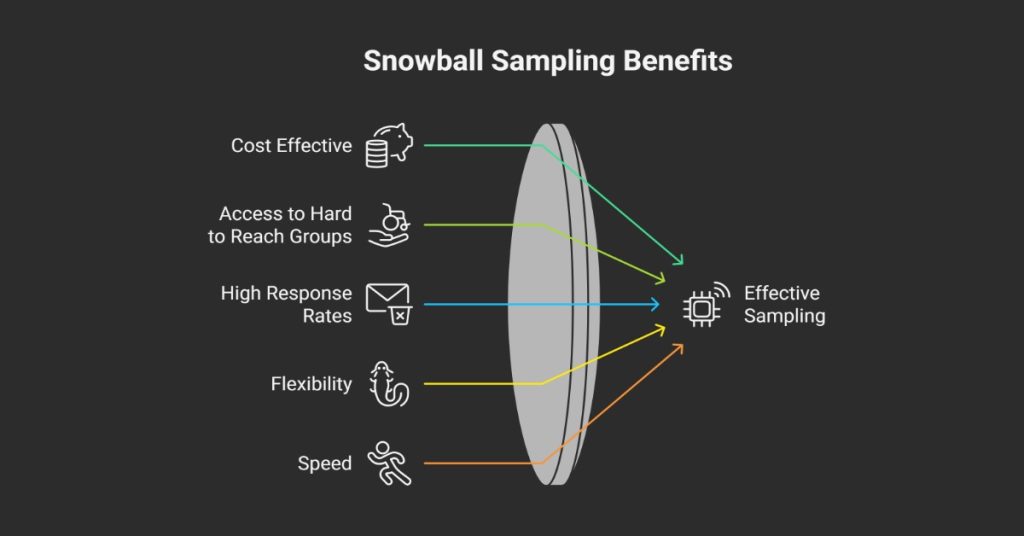Snowball sampling is a non-probability sampling technique widely used in qualitative research, particularly when studying hard-to-reach or niche populations. Unlike traditional random sampling, it relies on existing study participants to recruit future subjects, creating a “snowball effect.” This method is invaluable in fields like sociology, public health, and market research, where accessing certain groups can be challenging.
In this blog, we’ll explore what snowball sampling is, its practical applications, and the key benefits it offers in 2025. We’ll also address common questions researchers have about this method, ensuring you have a comprehensive understanding of its strengths and limitations.
Table of Contents
What Is Snowball Sampling?
It is a research methodology where initial participants refer or recruit additional participants from their networks. This technique is especially useful when studying hidden or marginalized populations, such as undocumented immigrants, drug users, or rare disease patients, where traditional sampling methods fall short.
The process begins with a small group of “seed” participants, who then recommend others who meet the study criteria. This chain continues until the desired sample size is reached or saturation is achieved.

Types of Snowball Sampling
- Linear Snowball Sampling: Participants refer one or two others, creating a straightforward chain.
- Exponential Non-Discriminative Snowball Sampling: Each participant refers to multiple others, rapidly expanding the sample.
- Discriminative Snowball Sampling: Researchers screen referrals to ensure they meet specific criteria.
Each type has its advantages, depending on the research goals and population characteristics.
Uses of Snowball Sampling in 2025
- Studying Hidden Populations
It is indispensable for researching groups that are difficult to identify or access, such as victims of human trafficking or members of underground communities.
- Market Research
Businesses use this method of sampling to gather insights from niche customer segments, such as luxury buyers or early adopters of new technologies.
- Public Health Studies
Researchers employ this method to study behaviors like substance abuse or HIV transmission in high-risk groups.
- Social Network Analysis
It helps map relationships and influence within networks, such as professional communities or activist groups.
- Qualitative Exploratory Research
When little is known about a topic, snowball sampling can help identify key informants and build foundational knowledge.
Key Benefits of Snowball Sampling
- Cost Effective
Traditional sampling methods often require extensive resources to locate participants. Whereas snowball sampling leverages existing networks, reducing costs.
- Access to Hard to Reach Groups
It bridges the gap between researchers and populations that are otherwise inaccessible due to stigma, legality, or privacy concerns.
- High Response Rates
Participants recruited through trusted referrals are more likely to engage, improving data quality.
- Flexibility
Researchers can adapt the sampling process as new insights emerge, making it ideal for exploratory studies.
- Speed
The method accelerates data collection, especially when time is a constraint.

Limitations of Snowball Sampling
While powerful, this method of sampling has drawbacks:
Bias: The sample may overrepresent certain subgroups within the population.
Lack of Generalizability: Findings may not apply to the broader population.
Dependence on Initial Seeds: Poorly chosen seeds can skew results.
Researchers must weigh these limitations against the method’s benefits when designing studies.
People Also Ask
How does snowball sampling differ from random sampling?
Random sampling selects participants purely by chance, ensuring representativeness. Snowball sampling relies on referrals, making it non-random but practical for niche groups.
When should I use snowball sampling?
Use it when studying hidden populations, conducting exploratory research, or when traditional sampling is impractical.
What are the ethical considerations of snowball sampling?
Researchers must ensure confidentiality, obtain informed consent, and avoid coercing participants into referrals.
Can snowball sampling be used in quantitative research?
While rare, it can supplement quantitative studies, especially when combined with other methods.
How do I minimize bias in snowball sampling?
Diversify seed participants, use screening criteria, and triangulate data with other sources.

Best Practices for Snowball Sampling in 2025
- Choose Diverse Seeds: Start with participants from varied backgrounds to reduce bias.
- Set Clear Criteria: Define who qualifies for the study to maintain consistency.
- Monitor Referrals: Track the chain to ensure it doesn’t become too homogenous.
- Combine Methods: Pair snowball sampling with other techniques for robust results.
- Ensure Ethical Compliance: Protect participant privacy and autonomy.
Read More
Cluster Sampling: A Guide to Advantages & Disadvantages with Examples
Data Collection Methods: A Complete Guide to Qualitative, Quantitative & Mixed Techniques
Likert Scale Examples: 5-Point & 7-Point Question Samples for Effective Surveys
Conclusion
Snowball sampling remains a vital tool in 2025 for researchers tackling hard to reach populations. Its cost effectiveness, flexibility, and ability to uncover hidden insights make it indispensable in qualitative and exploratory studies. However, understanding its limitations and applying best practices is crucial for reliable outcomes.

